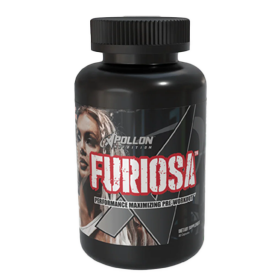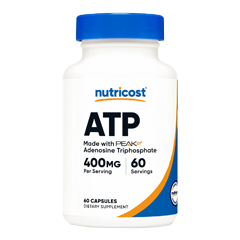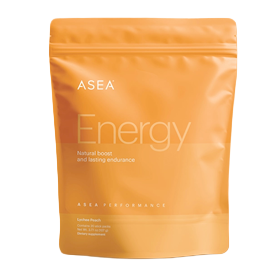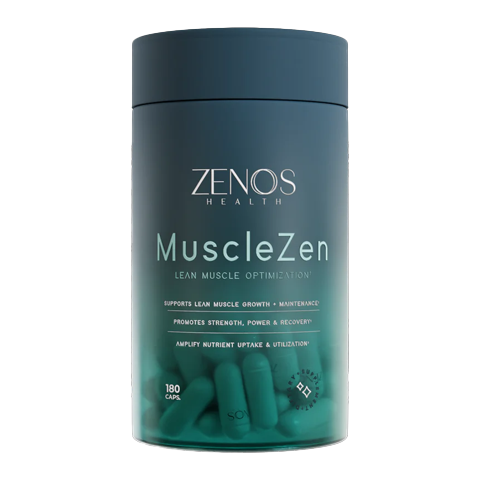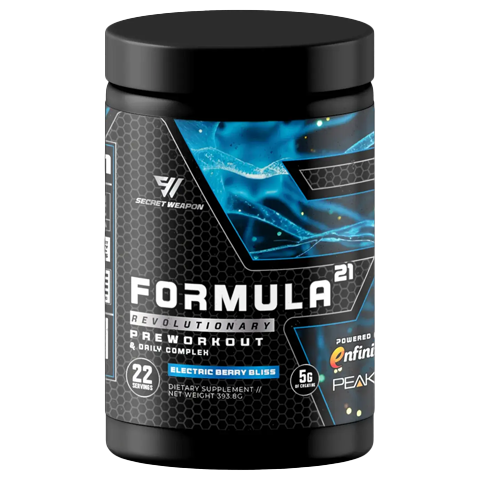The Slam Ball
The slam ball is similar to a medicine ball, but it is constructed slightly different and designed to minimize the bounce. It is a relatively new piece of exercise equipment when compared to the long history of the medicine ball, that dates to ancient Greece. The slam ball can be used for a variety of movements such as overhead ball slams, overhead throws, rotational throws, sit ups and many other exercises. It is an inexpensive training tool that is available in a wide range of weights between 2 to 200 lbs.
I added slam balls to my training about ten years ago. I got hooked on them right away, and I use them almost every workout. My primary exercise is the overhead ball slam. Therefore, this article will focus on that movement. I have various slam balls at the gym weighing between 10 and 50 lbs. However, I prefer the ballistic nature of slamming a 25 lb. ball versus slamming the heavier ones. When training younger athletes, or athletes that participate in sports like volleyball, track and field, and basketball we generally stay between 10-15 lbs. The goal is to slam the ball down with a violent force for each repetition. In doing so, you are trying to generate explosive power. You don’t want to sacrifice speed by going too heavy. We always make the goal to slam the ball down hard enough that it can be caught off the slight bounce. By using this technique, the ball can be retrieved, just off the ground, in a good position to go into the next repetition.
Overhead Ball Slam
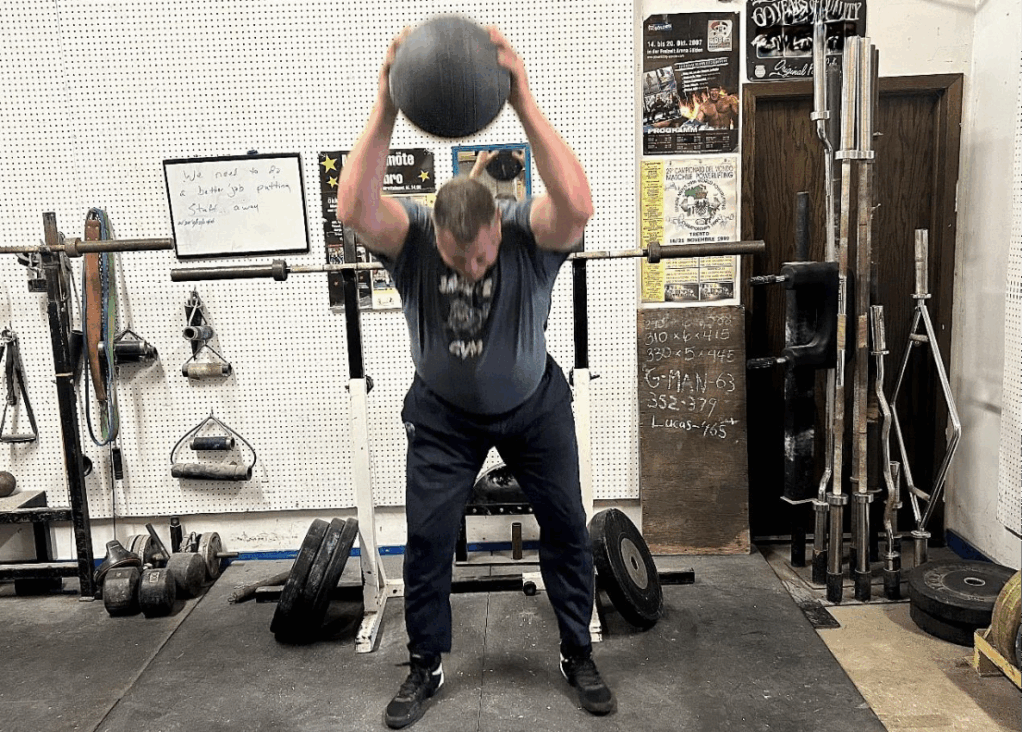
The overhead ball slam targets multiple muscle groups including legs, core, arms, shoulders, and back.1 This movement can be used for a dynamic warm up, for power development, conditioning circuits, and as a post-activation potentiation (PAP) conditioning exercise. The overhead ball slam is executed in a standing position with feet positioned at shoulder width and both hands on the ball. The ball is then raised overhead, extending the body up onto the toes, and slammed down using the entire body. It is a full body plyometric movement that gets your body heated up, cranks up the nervous system, gets you breathing hard, and increases your heart rate. When I use overhead ball slams to warm up, I include it with other dynamic exercises for 3 sets of 5-10 reps, increasing speed and effort with each set.
Ball Slams as a PAP Conditioning Exercise
A typical strength-power complex involves a heavy conditioning exercise like the squat, completed at 80-90% your one repetition maximum (1 RM) for a set of 3-5 repetitions, followed by a rest interval, and then a plyometric movement like a depth jump or counter movement jump. The high intensity resistance exercise activates muscle fiber recruitment and stimulates the central nervous system. However, research indicates that high intensity muscle actions from plyometrics can also benefit maximal performance.2 With this thought in mind, I like to include an explosive ball slam within a minute prior to completing a heavy set or heavy single repetition. I feel that the ball slam induces a more intense approach to the lift by increasing my psych up, recruiting muscle fibers, and cranking up the nervous system. I also like to incorporate this method during a speed squat, speed bench, or speed deadlift training session. For example: each of the 8 sets of 2 repetitions (60-70% 1 RM) in the bench are proceeded with an intense ball slam.
Ball Slams to Increase Explosive Power
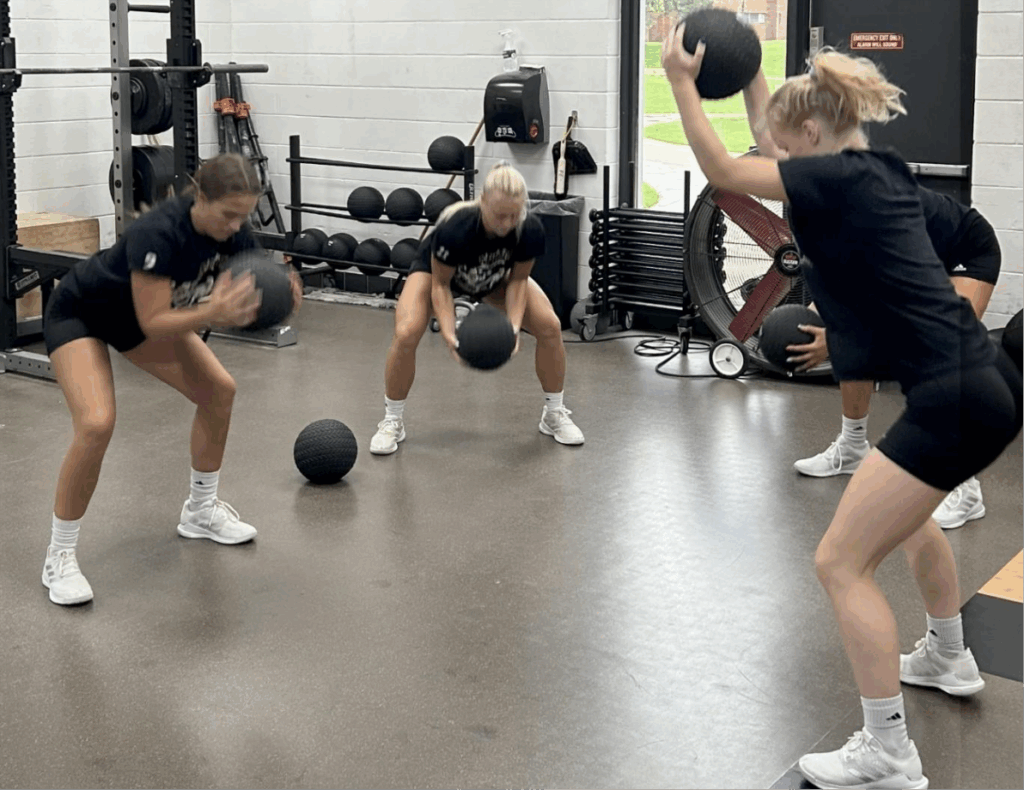
Overhead slams are a great exercise to increase explosive power in athletes. I program 3-5 sets of 5-10 repetitions multiple times per week with a variety of athletes that I coach. They are usually included in an assistance circuit following the core lifts. Overhead slams require the athlete to generate explosive power from the entire body. We instruct the athletes to throw the ball down as violently as possible and to catch it off the slight bounce to transition into the next repetition. I find that most athletes really enjoy this movement.
Ball Slams as a Conditioning Exercise
I like to include heavy strength and conditioning circuits into my training. These circuits are especially valuable for sports like wrestling and football that require athletes to develop absolute strength, power, strength endurance, and a high level of physical fitness. My favorite heavy strength and conditioning circuit (The Skriptnoid) always starts with a set of 5 ball slams. This is followed by 1 repetition in the log press, deadlift and sandbag load, and then finished with sled push/pull or farmers walks.3 These types of circuits are standalone work outs or programmed at the end of a session. The ball slam really cranks up your heart rate and adds to the conditioning effect of this type of metabolic finisher.
Replacing the Slam Ball with a Medicine Ball when Training Away from Home
I recently wrote an article about the importance of getting in some kind of training when travel has you away from home for an extended period. Getting in an improvised workout with whatever equipment the hotel gym provides starts the day out right, kick starts your metabolism and helps you get rid of the travel blahs.4 If you are training away from home, you may not find a slam ball, but a lot of hotel fitness rooms have medicine balls as standard equipment. Medicine balls have a livelier bounce but slamming a medicine ball is a great part of any conditioning circuit. You can combine this movement with whatever equipment is available like kettlebell swings, goblet squats, push-ups, curls, lunges, shrugs, and rows.
Don’t Forget to Include Overhead Ball Slams into your Training
If you aren’t training overhead ball slams now is the time. Slam balls are a versatile piece equipment that can help you meet many of your strength training and fitness goals in the areas of mobility, strength, power and physical fitness. Start Slamming and Stay Strong!!
Brad Gillingham
CSCS
MSC Southern Utah University
Fuel Your Training Session with ATP
ATP is your body’s primary energy currency, powering every muscle contraction during training. PEAK ATP® delivers a patented, clinically researched form of adenosine triphosphate to help you push harder, sustain performance, and get the most out of every workout.
References:
- Fit Living. Fitness slam balls: Strength training. Living.Fit. May 22, 2024. https://www.living.fit/blogs/news/smash-your-fitness-goals-with-slam-balls#:~:text=Cardiovascular%20Conditioning,enhancing%20aerobic%20capacity%20and%20stamina.
- Andrade D, Henriquez-Olguin C, Beltran A, et al. Effects of general, specific and combined warm-up on explosive muscular performance. Biology of Sport. 2014;32(2):123-128. doi:10.5604/20831862.1140426
- Andrusyk M. The heavy strength and Conditioning Circuit: Brad Gillingham. myHMB®. August 8, 2024. https://myhmb.com/the-heavy-strength-and-conditioning-circuit/.
- Reiz P. Training on the road: Staying strong while you travel. myHMB®. April 24, 2025. https://myhmb.com/training-on-the-road-staying-strong-while-you-travel/.





